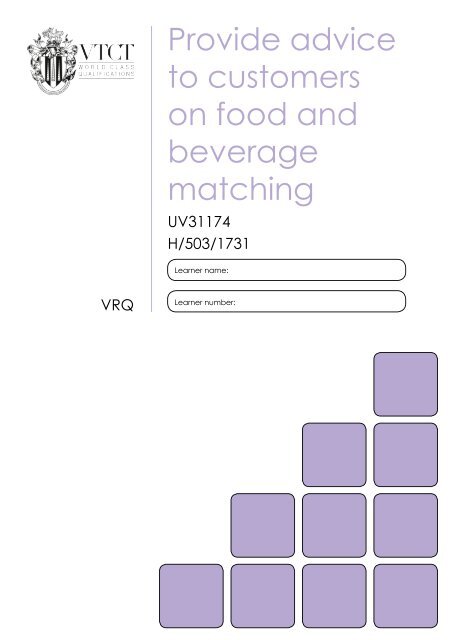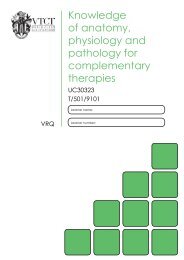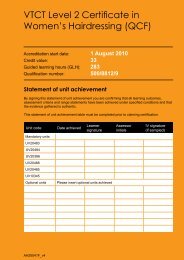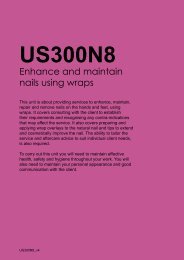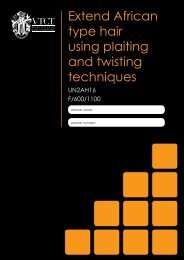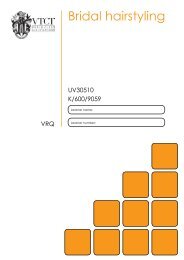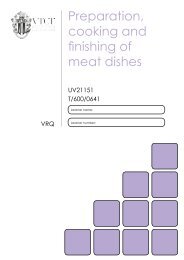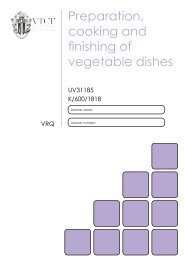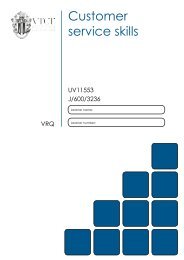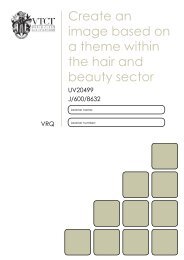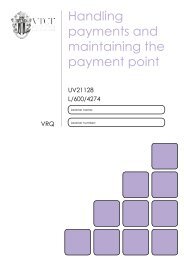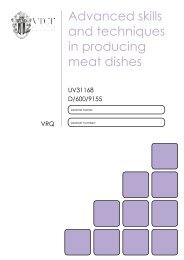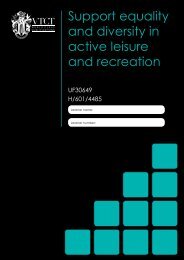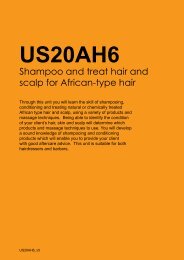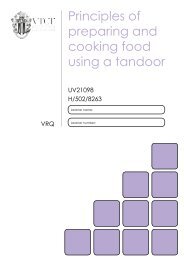Provide advice to customers on food and beverage matching - VTCT
Provide advice to customers on food and beverage matching - VTCT
Provide advice to customers on food and beverage matching - VTCT
Create successful ePaper yourself
Turn your PDF publications into a flip-book with our unique Google optimized e-Paper software.
VRQ<br />
<str<strong>on</strong>g>Provide</str<strong>on</strong>g> <str<strong>on</strong>g>advice</str<strong>on</strong>g><br />
<str<strong>on</strong>g>to</str<strong>on</strong>g> cus<str<strong>on</strong>g>to</str<strong>on</strong>g>mers<br />
<strong>on</strong> <strong>food</strong> <strong>and</strong><br />
<strong>beverage</strong><br />
<strong>matching</strong><br />
UV31174<br />
H/503/1731<br />
Learner name:<br />
Learner number:
Statement of unit achievement<br />
By signing this statement of unit achievement you are c<strong>on</strong>firming that all learning outcomes, assessment<br />
criteria <strong>and</strong> range statements have been achieved under specified c<strong>on</strong>diti<strong>on</strong>s <strong>and</strong> that the evidence<br />
gathered is authentic.<br />
This statement of unit achievement table must be completed prior <str<strong>on</strong>g>to</str<strong>on</strong>g> claiming certificati<strong>on</strong>.<br />
Unit code Date achieved Learner signature<br />
Assessor tracking table<br />
<strong>VTCT</strong> is the specialist awarding body for the Hairdressing, Beauty Therapy, Complementary Therapy,<br />
Hospitality <strong>and</strong> Catering <strong>and</strong> Sport <strong>and</strong> Active Leisure sec<str<strong>on</strong>g>to</str<strong>on</strong>g>rs, with over 50 years of experience.<br />
<strong>VTCT</strong> is an awarding body regulated by nati<strong>on</strong>al organisati<strong>on</strong>s including Ofqual, SQA, DfES <strong>and</strong> CCEA.<br />
<strong>VTCT</strong> is a registered charity investing in educati<strong>on</strong> <strong>and</strong> skills but also giving <str<strong>on</strong>g>to</str<strong>on</strong>g> good causes in the area<br />
of facial disfigurement.<br />
Assessor name Assessor signature<br />
Assessor<br />
initials<br />
Assessors<br />
initials<br />
IV signature<br />
(if sampled)<br />
All assessors using this Record of Assessment book must complete this table. This is required for<br />
verificati<strong>on</strong> purposes.<br />
Assessor number<br />
(opti<strong>on</strong>al)
UV31174<br />
<str<strong>on</strong>g>Provide</str<strong>on</strong>g> <str<strong>on</strong>g>advice</str<strong>on</strong>g> <str<strong>on</strong>g>to</str<strong>on</strong>g> cus<str<strong>on</strong>g>to</str<strong>on</strong>g>mers <strong>on</strong><br />
<strong>food</strong> <strong>and</strong> <strong>beverage</strong> <strong>matching</strong><br />
The aim of this unit is <str<strong>on</strong>g>to</str<strong>on</strong>g> develop your knowledge <strong>and</strong><br />
underst<strong>and</strong>ing of <strong>food</strong> <strong>and</strong> <strong>beverage</strong> <strong>matching</strong>. Many<br />
cus<str<strong>on</strong>g>to</str<strong>on</strong>g>mers enjoy an alcoholic <strong>beverage</strong> with their meal,<br />
however, they may need support <strong>and</strong> expertise from staff<br />
when choosing a <strong>beverage</strong> <str<strong>on</strong>g>to</str<strong>on</strong>g> match their chosen <strong>food</strong>.<br />
You will study the various combinati<strong>on</strong>s of <strong>food</strong> <strong>and</strong><br />
<strong>beverage</strong>s which are c<strong>on</strong>sidered appropriate matches.<br />
You will also put your new skills in<str<strong>on</strong>g>to</str<strong>on</strong>g> practice by advising<br />
cus<str<strong>on</strong>g>to</str<strong>on</strong>g>mers <strong>on</strong> the selecti<strong>on</strong> of <strong>beverage</strong>s <str<strong>on</strong>g>to</str<strong>on</strong>g> match the<br />
<strong>food</strong>s they have chosen.<br />
UV31174_v5
Level<br />
Credit value<br />
GLH<br />
3<br />
4<br />
32<br />
Observati<strong>on</strong>(s)<br />
2<br />
External paper(s)<br />
0
<str<strong>on</strong>g>Provide</str<strong>on</strong>g> <str<strong>on</strong>g>advice</str<strong>on</strong>g> <str<strong>on</strong>g>to</str<strong>on</strong>g> cus<str<strong>on</strong>g>to</str<strong>on</strong>g>mers <strong>on</strong><br />
<strong>food</strong> <strong>and</strong> <strong>beverage</strong> <strong>matching</strong><br />
Learning outcomes<br />
On completi<strong>on</strong> of this unit you will:<br />
1. Be able <str<strong>on</strong>g>to</str<strong>on</strong>g> provide <str<strong>on</strong>g>advice</str<strong>on</strong>g> <str<strong>on</strong>g>to</str<strong>on</strong>g> cus<str<strong>on</strong>g>to</str<strong>on</strong>g>mers <strong>on</strong><br />
<strong>food</strong> <strong>and</strong> <strong>beverage</strong> <strong>matching</strong><br />
2. Underst<strong>and</strong> how <str<strong>on</strong>g>to</str<strong>on</strong>g> provide <str<strong>on</strong>g>advice</str<strong>on</strong>g> <str<strong>on</strong>g>to</str<strong>on</strong>g><br />
cus<str<strong>on</strong>g>to</str<strong>on</strong>g>mers <strong>on</strong> <strong>food</strong> <strong>and</strong> <strong>beverage</strong> <strong>matching</strong><br />
Evidence requirements<br />
1. Envir<strong>on</strong>ment<br />
Evidence for this unit may be gathered<br />
within the workplace or realistic working<br />
envir<strong>on</strong>ment (RWE).<br />
2. Simulati<strong>on</strong><br />
Simulati<strong>on</strong> may be used in this unit, where<br />
no naturally occurring evidence is available.<br />
3. Observati<strong>on</strong> outcomes<br />
Competent performance of Observati<strong>on</strong><br />
outcomes must be dem<strong>on</strong>strated <strong>on</strong><br />
at least two occasi<strong>on</strong>s. Assessor<br />
observati<strong>on</strong>s, witness testim<strong>on</strong>ies <strong>and</strong><br />
products of work are likely <str<strong>on</strong>g>to</str<strong>on</strong>g> be the most<br />
appropriate sources of performance<br />
evidence. Professi<strong>on</strong>al discussi<strong>on</strong> may be<br />
used as supplementary evidence for those<br />
criteria that do not naturally occur.<br />
Assessed observati<strong>on</strong>s should not be<br />
carried out <strong>on</strong> the same day for the<br />
same learning outcome. There should be<br />
sufficient time between assessments for<br />
reflecti<strong>on</strong> <strong>and</strong> pers<strong>on</strong>al development.<br />
You need <str<strong>on</strong>g>to</str<strong>on</strong>g> meet the same st<strong>and</strong>ard <strong>on</strong> a<br />
regular <strong>and</strong> c<strong>on</strong>sistent basis. Separating<br />
the assessments by a period of at least two<br />
weeks is recommended as competence<br />
must be dem<strong>on</strong>strated <strong>on</strong> a c<strong>on</strong>sistent <strong>and</strong><br />
regular basis.<br />
4. Range<br />
All ranges must be practically dem<strong>on</strong>strated<br />
or other forms of evidence produced <str<strong>on</strong>g>to</str<strong>on</strong>g><br />
show they have been covered.<br />
5. Knowledge outcomes<br />
There must be evidence that you possess<br />
all the knowledge <strong>and</strong> underst<strong>and</strong>ing<br />
listed in the Knowledge secti<strong>on</strong> of this<br />
unit. In most cases this can be d<strong>on</strong>e<br />
by professi<strong>on</strong>al discussi<strong>on</strong> <strong>and</strong>/or oral<br />
questi<strong>on</strong>ing. Other methods, such as<br />
projects, assignments <strong>and</strong>/or reflective<br />
accounts may also be used.<br />
6. Tu<str<strong>on</strong>g>to</str<strong>on</strong>g>r/Assessor guidance<br />
You will be guided by your tu<str<strong>on</strong>g>to</str<strong>on</strong>g>r/assessor<br />
<strong>on</strong> how <str<strong>on</strong>g>to</str<strong>on</strong>g> achieve learning outcomes <strong>and</strong><br />
cover ranges in this unit. All outcomes <strong>and</strong><br />
ranges must be achieved.<br />
7. External paper<br />
There is no external paper requirement for<br />
this unit.<br />
UV31174<br />
3
4<br />
Achieving observati<strong>on</strong>s<br />
<strong>and</strong> range<br />
Achieving observati<strong>on</strong> outcomes Achieving range<br />
Your assessor will observe your performance<br />
of practical tasks. The minimum number of<br />
competent observati<strong>on</strong>s required is indicated in<br />
the Evidence requirements secti<strong>on</strong> of this unit.<br />
Criteria may not always naturally occur during<br />
a practical observati<strong>on</strong>. In such instances you<br />
will be asked questi<strong>on</strong>s <str<strong>on</strong>g>to</str<strong>on</strong>g> dem<strong>on</strong>strate your<br />
competence in this area. Your assessor will<br />
document the criteria that have been achieved<br />
through professi<strong>on</strong>al discussi<strong>on</strong> <strong>and</strong>/or oral<br />
questi<strong>on</strong>ing. This evidence will be recorded<br />
by your assessor in written form or by other<br />
appropriate means.<br />
Your assessor will sign off a learning outcome<br />
when all criteria have been competently<br />
achieved.<br />
UV31174<br />
The range secti<strong>on</strong> indicates what must<br />
be covered. Ranges should be practically<br />
dem<strong>on</strong>strated as part of an observati<strong>on</strong>. Where<br />
this is not possible other forms of evidence may<br />
be produced. All ranges must be covered.<br />
Your assessor will document the portfolio<br />
reference <strong>on</strong>ce a range has been competently<br />
achieved.
Learning outcome 1<br />
You can:<br />
a. Promote <strong>beverage</strong>s that will enhance the<br />
combinati<strong>on</strong> of <strong>food</strong> <strong>and</strong> <strong>beverage</strong>s<br />
b. Assist cus<str<strong>on</strong>g>to</str<strong>on</strong>g>mers in <strong>beverage</strong> selecti<strong>on</strong><br />
according <str<strong>on</strong>g>to</str<strong>on</strong>g> taste <strong>and</strong> price preference<br />
c. Offer specific <str<strong>on</strong>g>advice</str<strong>on</strong>g> <strong>on</strong> the compatibility of<br />
different <strong>beverage</strong>s with menu or <strong>food</strong> items<br />
Observati<strong>on</strong>s<br />
Be able <str<strong>on</strong>g>to</str<strong>on</strong>g> provide <str<strong>on</strong>g>advice</str<strong>on</strong>g> <str<strong>on</strong>g>to</str<strong>on</strong>g> cus<str<strong>on</strong>g>to</str<strong>on</strong>g>mers <strong>on</strong> <strong>food</strong> <strong>and</strong> <strong>beverage</strong><br />
<strong>matching</strong><br />
*May be assessed by supplementary evidence.<br />
Observati<strong>on</strong> 1 2 Opti<strong>on</strong>al Opti<strong>on</strong>al<br />
Criteria questi<strong>on</strong>ed orally<br />
Date achieved<br />
Portfolio reference<br />
Learner signature<br />
Assessor initials<br />
UV31174<br />
5
6<br />
Range<br />
You must practically dem<strong>on</strong>strate that you have:<br />
Assisted cus<str<strong>on</strong>g>to</str<strong>on</strong>g>mers in <strong>beverage</strong> selecti<strong>on</strong> using a minimum of<br />
8 different preferences<br />
Light<br />
Full Light<br />
Sweet<br />
Dry<br />
Sparkling<br />
Still<br />
House wine<br />
Medium priced<br />
Top of the range wines<br />
By the glass<br />
Carafe<br />
Half bottles<br />
By the bottle<br />
Offered specific <str<strong>on</strong>g>advice</str<strong>on</strong>g> <strong>on</strong> the compatibility of different<br />
<strong>beverage</strong>s with a minimum of 3 menu or <strong>food</strong> items<br />
Chocolate<br />
Fruits<br />
Soup<br />
Eggs<br />
Curry<br />
Chilli<br />
UV31174<br />
Portfolio reference<br />
Portfolio reference<br />
It is str<strong>on</strong>gly recommended that all range items are practically dem<strong>on</strong>strated. Where this is not<br />
possible, other forms of evidence may be produced <str<strong>on</strong>g>to</str<strong>on</strong>g> dem<strong>on</strong>strate competence.
Achieving knowledge outcomes<br />
You will be guided by your tu<str<strong>on</strong>g>to</str<strong>on</strong>g>r <strong>and</strong> assessor<br />
<strong>on</strong> the evidence that needs <str<strong>on</strong>g>to</str<strong>on</strong>g> be produced.<br />
Your knowledge <strong>and</strong> underst<strong>and</strong>ing will be<br />
assessed using the assessment methods listed<br />
below*:<br />
• Projects<br />
• Observed work<br />
• Witness statements<br />
• Audio-visual media<br />
• Evidence of prior learning or attainment<br />
• Written questi<strong>on</strong>s<br />
• Oral questi<strong>on</strong>s<br />
• Assignments<br />
• Case studies<br />
• Professi<strong>on</strong>al discussi<strong>on</strong><br />
Where applicable your assessor will integrate<br />
knowledge outcomes in<str<strong>on</strong>g>to</str<strong>on</strong>g> practical observati<strong>on</strong>s<br />
through professi<strong>on</strong>al discussi<strong>on</strong> <strong>and</strong>/or oral<br />
questi<strong>on</strong>ing.<br />
When a criteri<strong>on</strong> has been orally questi<strong>on</strong>ed<br />
<strong>and</strong> achieved, your assessor will record this<br />
evidence in written form or by other appropriate<br />
means. There is no need for you <str<strong>on</strong>g>to</str<strong>on</strong>g> produce<br />
additi<strong>on</strong>al evidence as this criteri<strong>on</strong> has already<br />
been achieved.<br />
Some knowledge <strong>and</strong> underst<strong>and</strong>ing outcomes<br />
may require you <str<strong>on</strong>g>to</str<strong>on</strong>g> show that you know <strong>and</strong><br />
underst<strong>and</strong> how <str<strong>on</strong>g>to</str<strong>on</strong>g> do something. If you have<br />
practical evidence from your own work that<br />
meets knowledge criteria, then there is no<br />
requirement for you <str<strong>on</strong>g>to</str<strong>on</strong>g> be questi<strong>on</strong>ed again <strong>on</strong><br />
the same <str<strong>on</strong>g>to</str<strong>on</strong>g>pic.<br />
*This is not an exhaustive list.<br />
Developing knowledge<br />
UV31174 7
8<br />
Knowledge<br />
Learning outcome 2<br />
Underst<strong>and</strong> how <str<strong>on</strong>g>to</str<strong>on</strong>g> provide <str<strong>on</strong>g>advice</str<strong>on</strong>g> <str<strong>on</strong>g>to</str<strong>on</strong>g> cus<str<strong>on</strong>g>to</str<strong>on</strong>g>mers <strong>on</strong> <strong>food</strong> <strong>and</strong><br />
<strong>beverage</strong> <strong>matching</strong><br />
You can: Portfolio reference<br />
a. Explain how <str<strong>on</strong>g>to</str<strong>on</strong>g> engage with cus<str<strong>on</strong>g>to</str<strong>on</strong>g>mers in discussi<strong>on</strong> <strong>on</strong> <strong>beverage</strong>s<br />
b. Explain how <str<strong>on</strong>g>to</str<strong>on</strong>g> support cus<str<strong>on</strong>g>to</str<strong>on</strong>g>mer’s <strong>beverage</strong> selecti<strong>on</strong> using a<br />
variety of techniques<br />
c. Explain why a range of <strong>food</strong>s <strong>and</strong> <strong>beverage</strong>s may be c<strong>on</strong>sidered <str<strong>on</strong>g>to</str<strong>on</strong>g><br />
be classic combinati<strong>on</strong>s<br />
d. Explain how the senses work in relati<strong>on</strong> <str<strong>on</strong>g>to</str<strong>on</strong>g> taste<br />
e. Explain how different <strong>food</strong>s can affect the palate <strong>and</strong> taste<br />
sensati<strong>on</strong><br />
f. Explain how <str<strong>on</strong>g>to</str<strong>on</strong>g> advise cus<str<strong>on</strong>g>to</str<strong>on</strong>g>mers <strong>on</strong> a range of <strong>food</strong> <strong>and</strong><br />
<strong>beverage</strong>s that may be c<strong>on</strong>sidered classic combinati<strong>on</strong>s<br />
g. Describe the type of language that should be used when<br />
describing attributes of <strong>beverage</strong>s including the terms aroma <strong>and</strong><br />
taste<br />
h. Explain where <str<strong>on</strong>g>to</str<strong>on</strong>g> obtain informati<strong>on</strong> needed regarding <strong>beverage</strong>s<br />
UV31174
Unit c<strong>on</strong>tent<br />
This secti<strong>on</strong> provides guidance <strong>on</strong> the recommended knowledge <strong>and</strong> skills required <str<strong>on</strong>g>to</str<strong>on</strong>g> enable you<br />
<str<strong>on</strong>g>to</str<strong>on</strong>g> achieve each of the learning outcomes in this unit. Your tu<str<strong>on</strong>g>to</str<strong>on</strong>g>r/assessor will ensure you have the<br />
opportunity <str<strong>on</strong>g>to</str<strong>on</strong>g> cover all of the unit c<strong>on</strong>tent.<br />
Outcome 1: Be able <str<strong>on</strong>g>to</str<strong>on</strong>g> provide <str<strong>on</strong>g>advice</str<strong>on</strong>g> <str<strong>on</strong>g>to</str<strong>on</strong>g> cus<str<strong>on</strong>g>to</str<strong>on</strong>g>mers <strong>on</strong> <strong>food</strong> <strong>and</strong> <strong>beverage</strong><br />
<strong>matching</strong><br />
Beverages that enhance the<br />
combinati<strong>on</strong> of <strong>food</strong> <strong>and</strong> <strong>beverage</strong>s:<br />
Red wines with red meats, white wines<br />
with white meats, full bodied wines with<br />
game, very dry wines with shellfish, sweet<br />
wines with desserts <strong>and</strong> soft cheeses,<br />
port with stil<str<strong>on</strong>g>to</str<strong>on</strong>g>n, br<strong>and</strong>y <strong>and</strong> liqueurs with<br />
coffee.<br />
Beverage selecti<strong>on</strong> according <str<strong>on</strong>g>to</str<strong>on</strong>g> taste<br />
<strong>and</strong> price preference: Taste (light or full<br />
bodied, sweet or dry, sparkling or still),<br />
price (house wine, medium priced, <str<strong>on</strong>g>to</str<strong>on</strong>g>p of<br />
the range wines).<br />
Compatibility: Appropriate wines with<br />
most <strong>food</strong>s, chocolate suggest a liqueur or<br />
br<strong>and</strong>y, fruits <strong>and</strong> soup suggest a fortified<br />
wine, eggs <strong>and</strong> vinegar suggest wine<br />
is avoided, str<strong>on</strong>g flavours (curry, chilli)<br />
suggest beers.<br />
UV31174 9
10<br />
Outcome 2: Underst<strong>and</strong> how <str<strong>on</strong>g>to</str<strong>on</strong>g> provide <str<strong>on</strong>g>advice</str<strong>on</strong>g> <str<strong>on</strong>g>to</str<strong>on</strong>g> cus<str<strong>on</strong>g>to</str<strong>on</strong>g>mers <strong>on</strong> <strong>food</strong> <strong>and</strong><br />
<strong>beverage</strong> <strong>matching</strong><br />
Discussi<strong>on</strong>s <strong>on</strong> <strong>beverage</strong>s: Opportunities<br />
(<strong>on</strong> arrival, offering the wine list, checking<br />
that cus<str<strong>on</strong>g>to</str<strong>on</strong>g>mers are satisfied), make<br />
suggesti<strong>on</strong>s of appropriate <strong>beverage</strong>s,<br />
ascertain if cus<str<strong>on</strong>g>to</str<strong>on</strong>g>mer is familiar with<br />
particular <strong>beverage</strong>s.<br />
Support cus<str<strong>on</strong>g>to</str<strong>on</strong>g>mer’s selecti<strong>on</strong> using<br />
a variety of techniques: Approve of<br />
cus<str<strong>on</strong>g>to</str<strong>on</strong>g>mer’s choice, recommend appropriate<br />
<strong>beverage</strong>s, cus<str<strong>on</strong>g>to</str<strong>on</strong>g>mer’s needs (financial<br />
limitati<strong>on</strong>, special occasi<strong>on</strong>s, nati<strong>on</strong>ality).<br />
Classic combinati<strong>on</strong>s: Light flavoured<br />
<strong>food</strong>s should not be overpowered by str<strong>on</strong>g<br />
flavoured wines, str<strong>on</strong>g flavoured <strong>food</strong>s will<br />
overpower light flavoured wines.<br />
Senses in relati<strong>on</strong> <str<strong>on</strong>g>to</str<strong>on</strong>g> taste: Taste (sweet,<br />
saline, bitter, sour), smell.<br />
Different <strong>food</strong>s can affect the palate <strong>and</strong><br />
taste sensati<strong>on</strong>: Chocolate, fruits, vinegar,<br />
eggs, str<strong>on</strong>g flavours.<br />
Advise cus<str<strong>on</strong>g>to</str<strong>on</strong>g>mers of a range of classic<br />
combinati<strong>on</strong>s: Red wines with red meats,<br />
white wines with white meats, full bodied<br />
wines with game, very dry wines with<br />
shellfish, sweet wines with desserts <strong>and</strong><br />
soft cheeses, port with stil<str<strong>on</strong>g>to</str<strong>on</strong>g>n, br<strong>and</strong>y <strong>and</strong><br />
liqueurs with coffee.<br />
Type of language: Aroma (fruity, vegetal,<br />
tropical fruit, vanillin, woody), taste (full<br />
bodied, sweet, dry, tannic, acidic, fruity).<br />
Informati<strong>on</strong> needed regarding<br />
<strong>beverage</strong>s: Wine merchant, nati<strong>on</strong>al<br />
wine marketing agencies, wine fairs, wine<br />
journals (Wine, Decanter), wine producers’<br />
websites <strong>and</strong> marketing material.<br />
UV31174


